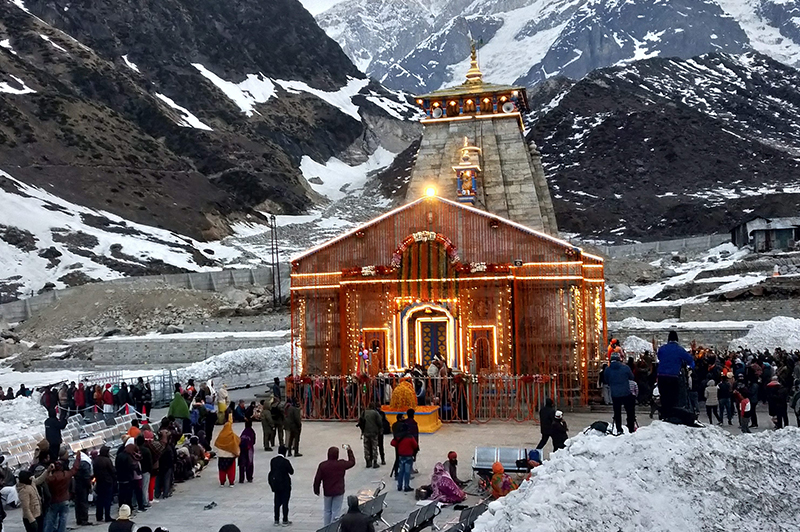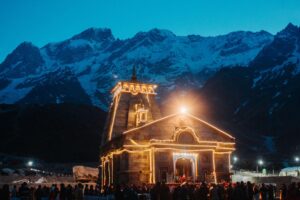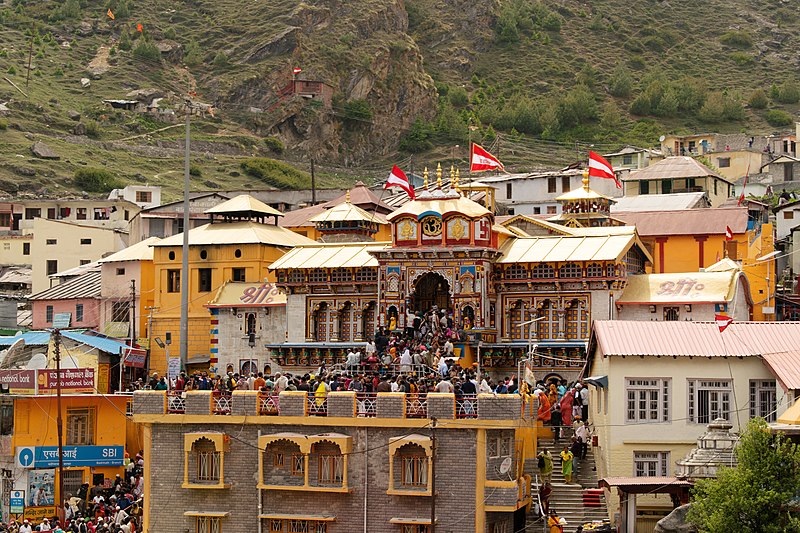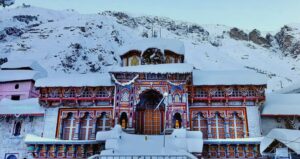The Char Dham Yatra, an important pilgrimage in Hinduism, includes four sacred sites: Yamunotri, Gangotri, Kedarnath, and Badrinath. Among these, Badrinath and Kedarnath stand out for their profound spiritual significance and stunning Himalayan landscapes. This blog delves into the essence of these two revered shrines, exploring their history, attractions, and practical travel tips for an enriching pilgrimage experience.
1. Kedarnath: The Abode of Lord Shiva
Kedarnath is one of the twelve Jyotirlingas dedicated to Lord Shiva, making it one of the holiest shrines in Hinduism. Located at an elevation of about 3,584 meters (11,765 feet) in the Garhwal Himalayas, Kedarnath offers a unique blend of spiritual significance and breathtaking natural beauty.
Historical Significance and Attractions
1. Kedarnath Temple:
- History: The Kedarnath Temple is believed to have been established by the Pandavas, the central characters of the Mahabharata. The temple, as we see it today, was reconstructed by Adi Shankaracharya in the 8th century. It holds immense spiritual value and is revered by millions of devotees annually.
- Architecture: The temple’s architecture features intricately carved stone walls and a distinctive pyramidal roof. The main shrine houses a lingam representing Lord Shiva, and the temple’s location amidst snow-capped peaks adds to its divine allure.

2. Bhairavnath Temple:
- Location: Situated a short distance from the Kedarnath Temple, the Bhairavnath Temple is dedicated to Lord Bhairav, a fierce manifestation of Lord Shiva. It is believed that visiting this temple wards off any negative energies and protects pilgrims.
- Significance: The temple’s historical and spiritual importance makes it an essential part of the Kedarnath pilgrimage, enhancing the overall spiritual experience of visitors.

3. Vasuki Tal:
- Location: About 6 kilometres from Kedarnath, Vasuki Tal is a high-altitude lake surrounded by majestic peaks. The serene environment and pristine waters of the lake make it a popular spot for trekkers and nature enthusiasts.
- Trekking: The trek to Vasuki Tal offers spectacular views of the surrounding mountains and glaciers, providing a peaceful retreat from the bustling pilgrimage atmosphere.

Travel and Accessibility
1. Trek to Kedarnath:
- Route: The trek to Kedarnath starts from Gaurikund, covering a distance of approximately 16 kilometres. The trail is steep and challenging, with rugged terrain and rocky paths. It usually takes around 6-8 hours to complete the trek.
- Transport: For those who prefer not to trek, ponies and palanquins (palanquins) are available for hire. These provide an alternative means of reaching the temple, though the trek is an integral part of the pilgrimage experience.
2. By Road:
- Route: Kedarnath is accessible by road up to Gaurikund. The journey from Rishikesh or Haridwar involves driving through scenic mountain roads, offering spectacular views of the Himalayan foothills. However, the road conditions can be challenging, especially during the monsoon season.
Practical Tips for Kedarnath
1. Health and Safety:
- Altitude Sickness: The high altitude can lead to altitude sickness. Ensure proper acclimatization and stay hydrated. Consult a doctor if you experience symptoms such as dizziness, nausea, or shortness of breath.
- Weather Preparation: Weather in Kedarnath can be unpredictable, with temperatures dropping significantly, especially in the evenings. Carry warm clothing and be prepared for sudden weather changes.
2. Accommodation:
- Options: Kedarnath offers basic accommodations, including Dharamshala and guesthouses. Due to the high influx of pilgrims during the season, it is advisable to book accommodations in advance.
2. Badrinath: The Sanctuary of Lord Vishnu
Badrinath is the final destination of the Char Dham Yatra and is dedicated to Lord Vishnu, one of the principal deities of Hinduism. Located at an altitude of about 3,133 meters (10,279 feet), Badrinath is nestled between the Nar and Narayan mountain ranges, providing a stunning backdrop to its spiritual significance.

Historical Significance and Attractions
1. Badrinath Temple:
- History: The Badrinath Temple is one of the most revered shrines in Hinduism. It is believed that the temple was originally established by the sage Narada and later rebuilt by Adi Shankaracharya in the 9th century. The temple has been a focal point of devotion and pilgrimage for centuries.
- Architecture: The temple’s architecture features a majestic entrance, intricately carved pillars, and a golden roof. The main deity, Lord Vishnu, is worshipped in the form of a black stone idol adorned with various ornaments.

2. Tapt Kund:
- Location: The Tapt Kund is a natural thermal spring located near the Badrinath Temple. Pilgrims take a holy dip in these warm waters before entering the temple as part of their purification ritual.
- Significance: The hot springs are believed to have medicinal properties and are an integral part of the pilgrimage experience at Badrinath.

3. Mana Village:
- Location: Located a few kilometres from Badrinath, Mana Village is the last village on the Indian side of the Indo-Tibetan border. The village is known for its scenic beauty and cultural heritage.
- Attractions: Mana Village is home to several notable sites, including the Vyas Gufa (cave) and Ganesh Gufa (cave). These sites are associated with the epic Mahabharata and offer a glimpse into the region’s rich cultural history.

Travel and Accessibility
1. By Road:
- Route: Badrinath is accessible by road from Rishikesh and Haridwar. The journey involves travelling through the scenic and rugged terrain of the Himalayan foothills. The road conditions can be challenging, so it’s advisable to travel in a reliable vehicle.
- Accommodation: Badrinath offers a range of accommodations, from budget guesthouses to more comfortable hotels. Due to the peak pilgrimage season, it is recommended to book accommodations in advance.
Practical Tips for Badrinath
1. Health and Safety:
- Altitude: The altitude can lead to discomfort and health issues. Ensure proper acclimatization and take necessary precautions to avoid altitude sickness.
- Weather: The weather in Badrinath can be unpredictable, with temperatures varying throughout the day. Carry warm clothing and be prepared for sudden weather changes.
2. Local Customs:
- Respect Traditions: Follow local customs and traditions while visiting the temple and interacting with locals. Dress modestly and seek permission before taking photographs, especially in religious areas.
3. Planning Your Visit:
1. Best Time to Visit:
- Season: The best time to undertake the Char Dham Yatra, including Badrinath and Kedarnath, is between May and October. During these months, the weather is relatively favourable, and the roads are open. The pilgrimage season is at its peak from May to September, with the temples usually closing for the winter months from November to April.
2. Travel Arrangements:
- Itinerary: Plan your itinerary, considering travel time between the shrines and the time required for trekking and exploration. It is advisable to allocate sufficient time for acclimatization and to enjoy the spiritual experience at each shrine.
- Permits: Ensure you have the necessary permits and documentation required for the pilgrimage. Some areas may have specific entry requirements, so check in advance and obtain any required permits.
3. Packing Essentials:
- Clothing: Pack warm and waterproof clothing, as temperatures can drop significantly, especially at high altitudes. Comfortable trekking shoes and warm layers are essential.
- Medical Kit: Carry a basic first-aid kit, personal medications, and any necessary altitude sickness remedies.
Challenges for Do Dham Yatra
The expedition of the Do Dham Yatra package unfolds amidst a myriad of challenges, necessitating meticulous preparation and fortitude from pilgrims:
- Harsh Terrain: Traversing the rugged Himalayan terrain entails negotiating treacherous paths, steep inclines, and unpaved trails, presenting formidable physical challenges to pilgrims.
- Altitude Sickness: The pilgrimage sites are ensconced at lofty altitudes, rendering pilgrims susceptible to altitude sickness, characterized by nausea, dizziness, and breathlessness.
- Limited Amenities: Basic amenities and accommodation facilities are sporadic in remote hinterlands, prompting pilgrims to acclimate to austere living conditions during their vacation.
- Weather Uncertainties: The Himalayan climate is characterized by capricious vagaries, with abrupt fluctuations in temperature, sporadic rainfall, and sporadic snowfall, potentially impeding travel arrangements.
Helicopter Service for Do Dham Yatra: A Convenient Pilgrimage Option
For pilgrims looking for a quicker and more comfortable way to visit Kedarnath and Badrinath, helicopter services offer an efficient alternative to traditional travel methods. These aerial services not only reduce travel time but also provide a unique opportunity to enjoy stunning Himalayan views.
Benefits of Helicopter Services
1. Reduced Travel Time:
- Helicopters significantly cut down the travel time to Kedarnath and Badrinath compared to road journeys or treks.
- This mode of transport is ideal for those who want to avoid the strenuous trek or have limited time.
2. Comfort and Accessibility:
- Helicopter services offer a smooth and comfortable travel experience, beneficial for elderly pilgrims or those with health concerns.
- Aerial views of the Himalayan landscape provide a memorable and scenic journey.
3. Scenic Aerial Views:
- Enjoy breathtaking views of the mountains, valleys, and rivers from above, adding a spectacular dimension to the pilgrimage.
Key Operators and Booking
1. Operators:
- Several operators offer helicopter services, including Pawan Hans, UTair India, and Aero Air. Choose a reputable provider for safety and reliability.
2. Booking:
- Book tickets in advance through official websites or travel agencies due to high demand, especially during peak seasons.
- Ensure all necessary documentation and permits are in order at the time of booking.
3. Prices and Packages:
- Compare prices and packages offered by different operators. Packages may cover both Kedarnath and Badrinath or offer individual flights.
Safety and Practical Tips
1. Safety Measures:
- Follow all safety instructions provided by the helicopter crew. Check weather conditions before flying as adverse weather can impact schedules.
2. Packing Essentials:
- Pack light due to luggage weight restrictions. Bring personal necessities like medications and snacks, and secure valuable items.
3. Health Considerations:
- Be aware of altitude-related issues and consult a doctor if necessary. Dress in weather-appropriate clothing and be prepared for temperature changes during the flight.
FAQs
Q-1: Is Do Dham Yatra amenable to elderly individuals?
Ans: While the pilgrimage may pose physical challenges, elderly pilgrims can undertake the journey with meticulous planning, medical supervision, and requisite assistance.
Q-2: Are accommodation amenities available en route?
Ans: Yes, accommodation facilities ranging from modest guesthouses to austere dharamshalas are dispersed along the pilgrimage trajectory. Advance reservations are advisable during peak pilgrimage seasons.
Q-3: Is Do Dham Yatra viable for solo travelers?
Ans: Solo travelers can indeed embark on the pilgrimage, albeit it is prudent to consort with organized tour groups or solicit guidance from experienced guides for an expedient and enriching pilgrimage experience.
Conclusion
Do Dham Yatra transcends the realm of pedestrian voyages, metamorphosing into an ethereal sojourn suffused with spiritual epiphany and celestial benediction. Pilgrims partaking in this sacred odyssey traverse beyond geographical terrains, delving into the recesses of their souls to unearth the essence of spiritual enlightenment. Despite the trials and tribulations strewn along the pilgrimage trajectory, the sanctified allure of Do Dham Yatra perseveres as an immutable bastion, beckoning the devout towards the sanctum of divine grace and eternal bliss. As pilgrims embark on this transformative odyssey, they are implored to embrace the spiritual revelations, cherish the divine memories, and nurture the sacred flame of faith that ignites their souls on the hallowed precincts of the Himalayas.
















3 Comments
Id vim facilis ceteros percipit, altera phaedrum sea at, te alia novum praesent sit. Ne justo mazim delenit eam, pri ex brute interpretaris, invenire.
Praesent finibus congue euismod. Nullam scelerisque massa vel augue placerat, a tempor sem egestas. Curabitur placerat finibus lacus.
Ut enim ad minim veniam, quis nostrud exercitation ullamco laboris nisi ut aliquip ex ea commodo consequat. Duis aute irure dolor in reprehenderit.